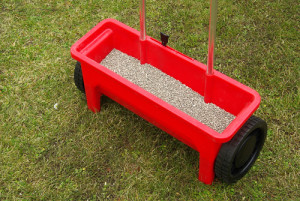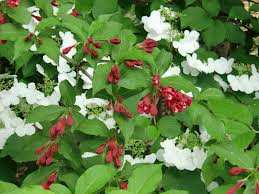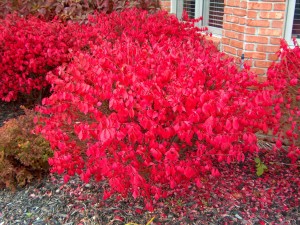Posts Tagged fall
Fall Garden Care
Fall is coming, and you should consider these useful tips as part of your garden care regime. After a flourishing summer of fighting weeds take pleasure in promoting a wholesome garden. This is truly a great time to entertain your family and friends in your backyard. By adhering to these easy fall garden care methods, you can ensure that it’s ready to be even more charming next spring.
Fall Garden Tips – Here’s What To Do
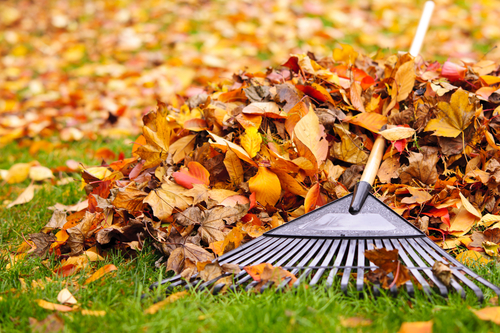
By the fall season, you should already be victorious in eradicating the weeds on your lawn. You should deal with any hold-outs before the leaves and snow make it too complex for you to handle. As it can be more difficult to handle the weeds. In addition, weeds can be extremely vigorous and can take over in the fall season when your lawn is less lively.
You should ensure that your lawn has an in-depth raking before snow falls. As time goes by, the leaves will begin to decay, depleting moisture out of the soil and encouraging a heartening dwelling for insects that may be damaging to your lawn. In addition, the plentiful layer of decomposed leaves may also leave behind dead spots in your lawn in the spring. Permitting weeds to rapidly move in and take over.
Over time, the soil of your lawn becomes flattened, decreasing the air pockets that permit nutrients and water to nourish the base of the roots. To fight this, ensure that you have your lawn aerated on a yearly basis. The best time to do this would be in the fall season. As it gives your lawn an opportunity to obtain the nutrients and water required for long term sustainability.
As your lawn matures it gets fatigued and the reproduction of your lawn decreases. Homeowners never want to see their lawns look unhealthy. It is suggested that your cover your entire lawn with grass seed before snow begins to fall. This will promote new lawn to start growing that will fill in the ailing areas. Consequently, next spring will have a winsome lawn outside.
There is an exceptional fall fertilizer that will assist your lawn with all the nutrients required to be wholesome in the fall season. This will encourage them to back even stronger in the spring season. It is better to fertilize early in the fall season to have your lawn charming and healthy in the autumn. Contact us and take pride in having a lawn that is luxurious.
Lawn Fertilizer – Fall Vs Winterizer Fertilizer – What’s the Difference?
If you own property, you probably know that you should fertilize the lawn. However, some home and business owners are unaware that lawn fertilization should be performed more than once per year. Fall fertilizer is required as is winterizer fertilizer. The winter variety is specially designed to help your grass make it through the winter while the fall fertilizer serves its own unique purposes. Let’s take a closer look at the differences between the two.
Fertilizer Overview
It is important to note that just about all bags of fertilizer have three numbers on the front. Each represents one of the primary ingredients within the fertilizer. These ingredients stand for potassium (K), phosphorous (P) and nitrogen (N). In general, lawn fertilizer formulas typically have a formula of 29-3-4. This means that the fertilizer has 29 percent nitrogen, 3 percent phosphorous and 4 percent potassium. Both fall and winterizer fertilizer stimulate root growth. Yet each contains its own unique mix of potassium, phosporous and nitrogen.
Fall Fertilizer
Fall fertilizer is specially designed to stimulate the growth of new roots. It contains a delicate balance of potassium and phosphorous designed to spur growth. This special blend allows the grass to “dig in” and prepare for the rough winter weather. Additionally, fall fertilizer sets the stage for the lawn’s roots to make full use of the winterizer fertilizer that will be added later in the year. Fall fertilizer works best when applied to soil that has a temperature that has dropped to a 70 degrees Fahrenheit. Yet it will not be as effective if applied when the soil temperature dips below 55 degrees.
Winterizer Fertilizer
Many lawn care experts are adamant that winterizer fertilizer is the most important of all fertilizer applications. It helps the roots of the grass absorb and store nutrients as they continue to grow until the ground eventually freezes at some point in the winter. These nutrients are then readily available when temperatures increase in the spring season.
Winterizer fertilizer should be applied about four to five weeks after the application of the fall fertilizer. Ideally, this will occur at some point in October or November. By this point, the new (but empty) roots have formed and the ground is moving toward the freezing mark. It is specially designed with high levels of nitrogen to promote the accumulation and storage of carbohydrates before the soil freezes. This nitrogen is held in reserve throughout the winter, in anticipation of the spring growing season. Winterizer fertilizer also contains more potassium than regular fertilizer. The role of the added potassium is to boost the grass’s tolerance for the cold and bolster the root systems.
Winterizer fertilizer does more than just prepare the grass for the nasty winter ahead. It also functions to feed the grass throughout the winter to keep it healthy and a lovely green shade (yes, even throughout the winter). Apply winterizer fertilizer in the proper amount at the right time and it will help your grass look an even more gorgeously rich green when the spring season rolls around a few months later. Aside from increasing grass aesthetics in the winter and spring, winterizer fertilizer’s influx of nutrients also induces quicker “green-up” growth in the early days of spring.
Your Lawn Deserves Both Fall and Winterizer Fertilizer
Do your lawn an enormous favor by applying both fall and winterizer fertilizer at the appropriate times. If you have any questions or concerns about your grass, landscaping or other outdoor maintenance issues like irrigation, water conservation or general repairs, do not hesitate to reach out to us for assistance.
Raking Leaves – for Aesthetics or Maintenance?
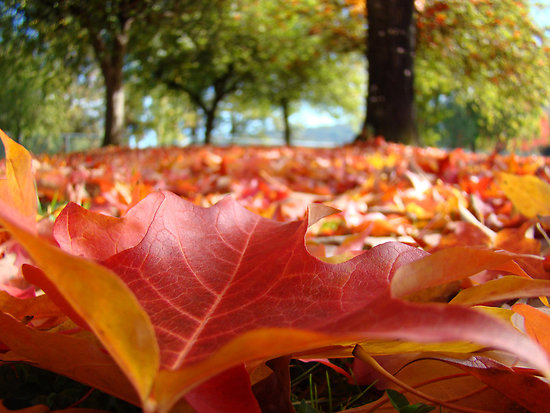 As wonderful as Autumn is, removing the fallen leaves from your lawn in the late fall is not generally regarded as a fun task. It’s time consuming and a bit tedious. You’ll be glad to know the payoff for all your labor goes beyond simply enhancing the curb appeal of your property. Removing fallen leaves is not only vital for the health of your lawn, but the beauty of it as well.
As wonderful as Autumn is, removing the fallen leaves from your lawn in the late fall is not generally regarded as a fun task. It’s time consuming and a bit tedious. You’ll be glad to know the payoff for all your labor goes beyond simply enhancing the curb appeal of your property. Removing fallen leaves is not only vital for the health of your lawn, but the beauty of it as well.
Excessive leaf matter on your lawn going into winter is bad for several reasons. Why you might ask? When your lawn becomes buried in layers of leaves, it becomes smothered and is deprived of water, air and nutrients it needs to survive. Without proper leaf removal your lawn will also become a breeding ground for fungi, disease and insects. Additionally, when leaves shade the grass they prevent it from receiving the sunlight it needs to thrive. While a few scattered leaves on the lawn won’t do much harm, a heavy thick layer will. Leaves left in place over the winter often become compacted and cause extensive damage to your lawn which can lead to increased costs and maintenance in the Spring.
Instead of raking the leaves, wait until they’re good and crunchy (ripe for jumping into), and then mow the leaves into little pieces. Then, you can just leave them! The leaves will serve as mulch and will protect the soil around your trees, shrubs, or garden.
Another option you have is to compost your leaves, but you simply can’t rake up all your leaves into a big pile and expect them to compost themselves. Composting requires regular turning of the leaves as well as the right amount of moisture.
Want to leave the fall clean-up work load for someone else? DK Landscaping Services offers both leaf removal and fall clean-up services. These services help ensure your landscape is clear of debris and fallen leaves are removed, preventing mold and fungus from growing. Give us a call (707) 280-3632.
Lawn Tricks and Treats for Winter Survival

When you think lawn care, spring may be the first thing that comes to mind, but the fact is back-to-school is perhaps an even better time to treat your lawn to some TLC.
October is no trick when it comes to setting up your lawn for better survival over the winter. And the treat, if done correctly, means a greener and healthier lawn next Spring for any lawn treatment done in October. Lawn care treatments are best done before soil temperatures drop to a level where your lawn is going into hibernation. are of particular. And seeding and fertilizations of any kind are more sensitive to warmer soils for maximum results in the fall. Here are some tips to follow for luscious lawn come spring:
Fertilizing
Natural and organic fertilizers also work best in warmer soils when micro-organisms are growing and can help breakdown the material into a useable form for your turf grass. By contrast, synthetic fertilizers are already in a more useable form and can be used later into the season as soils cool down. The cautionary note of using fertilizers too late in the season if theground is frozen or very cold means not really achieving any benefit to the lawn and the possibility of runoff into streams, rivers, and other undesirable areas.
Core Aeration and Lime
Over time your soil naturally becomes compacted and builds up acidity, leaving the subsoil undesirable for healthy lawn growth. Walking, playing, mowing and watering compacts the grass and reduce the air space necessary for root growth. Highly acidic soil will hinder the growth of a full, thriving lawn and will therefore promote weed growth. Combat compaction and aid in weed control with a core aeration and lime application.
Seeding
Seeding your lawn in early October can give you a beautiful, green lawn this winter. It is especially a smart option when facing a mixed stand lawn or patch stand of grasses. This will help hide and even the uniformity of the lawn. As the trees grow larger and produce more shade, the bermuda lawns start thinning out and the ryegrass can provide some much needed cover in those areas.
Winterizing
Remove piles of leaves on your lawn, especially on thin, shaded, or new grass areas, as they will act as mulch and damage your lawn. As the temperature drops and November approaches, you can actually drop your mowing height down to 2”. Your final cut in November should be 1.5” to help minimize winter damage.
And lastly…
Be patient. We all want the quick fix to a green and lush lawn, but it can take a couple seasons for a lawn to really take hold and fill in. If you are patient, you will be rewarded. Have questions? Email or call us, we at DK Landscaping will talk you through it!
Fall Landscaping Tips and Tricks
Sonoma County embraces the fall season as temperatures begin to dip and daylight begins to wane. It marks a time of change when our summer perennials and annuals die back, the leaves fall from the trees, and our irrigation systems get turned down.
Fall is an opportune time when we should welcome a change in landscape by dressing up your yard with some of fall’s favorites like mums, gourd’s, pumpkins! They are everywhere, in a variety of colors, from yellow to deep red.

MUMS are inexpensive and can be purchased just about everywhere. They make for great boarders, or can be planted in mass for a striking display. And the best thing, they are hardy perennials and can withstand low temperatures and frost. If planted early enough they will come back next spring. As an alternative to mums, you can use Coleus, Sedum, Firethorn, Snap Dragons, and Pansies to add stunning beauty to your landscape. Throw a few pumpkins in the mix and you’ve got a gorgeous garden display.
TREES are another way to spruce up your landscaping. They are not only beautiful but require less work than your summer-time trees. DK Landscaping recommends Hickory, redbud, sugar maples, and birch trees create marvelous landscapes of fall color. 
Lastly, don’t forget to incorporate hay bales, pine straw, pumpkins, gourds, cornstalks and potted plants – all that the harvest season has to offer!
Just following these simple fall tips and tricks will make your landscape pop with color, and keep your landscape looking beautiful and colorful all season long. It will make your home extra inviting for visitors including some little ghosts and goblins on Halloween night.
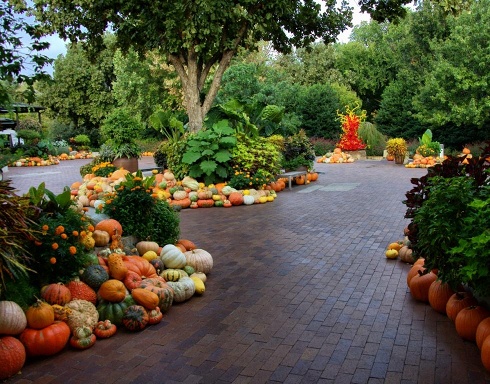
DK Landscaping is your Northern California’s premier’s landscaping company. For more information and/or a free consultation how we can add a little color to your fall life, please give us call (707) 280-3632.
Goodbye Summer. Hello Autumn!

Autumn is officially here in Sonoma County! When we think of the season, we think of vibrant foilage, crunchy leaves, the smell of crisp sweet air, pumpkins, hot apple cider and Halloween. But as we get further into the season, the sunlight begins to wane, the nights are chillier, our trees are more bare and the landscape looks tired. It’s easy for us at this point to hang up our boots, turn our backs on our landscape and take up shelter for warmth. But the reality is that Autumn is the most ideal time to tend to our lawns and prepare it for the harsh winter ahead to ensure it’s in the best of health for a springier spring. Here are DK Landscaping’s top tips to winterize your landscape:
Mow & Mulch
Mow your lawn into the fall and avoid removing more than one-third of the leaf blades with each cut. Return grass clippings and back to the soil for added lawn nutrients and use tree leaf compost to nourish plants. That will allow more sunlight to reach the crown of the grass, and there will be less leaf to turn brown during the winter.
Aerate & Prune
Aerating is a lawn process that puts small holes into the ground to allow air, water, and nutrients to transcend into the ground and allows you to remove unwanted weeds from manifesting. Help your lawn breathe through fall core aeration to strengthen roots and to prepare for a hardy spring workout. Conduct corrective pruning of trees and shrubs in fall to enhance plant appearance and vigor, and thin rather than top-shear and overgrown shrubs and flowering trees to preserve their overall shape.
Rake those Leaves
Don’t wait until all the leaves have fallen from the trees to start raking. If you do, the leaves will become wet from rain and morning dew, stick together and form an impenetrable mat that, if left there, will suffocate the grass and breed fungal diseases.
Feed for the Winter
A good fall feeding gives roots of lawns, trees and shrubs the energy needed to prepare for a healthy spring green revival. Keep fertilizer on target to prevent run-off and sweep fertilizer granules that may reach pavement back onto your lawn.
DK Landscaping is your Sonoma County lawn experts. We have all the tools, experience and are backed by 10 years trusted guaranteed service. Give us a call so we can help make your lawn beautiful! For a full list of services, please contact Kathy Lee at (707) 280-3632 or contact us by email, davidmunlee@aol.com.
Fall Lawn Care Tips
Many people have this false belief that as fall and winter approach, they need to spend less time on their lawn because grass grows more slowly in these months. The truth is, this is the time of year grass is busily absorbing energy, moisture, and nutrients in preparation for a long, dormant winter. Give your lawn the attention it deserves now, and you’ll be rewarded with a lush, healthy lawn in the springtime. DK Landscaping provides you with these simple tips:
1. Aerate: Aeration is important because it gives your lawn a chance to breath in autumn and provides room for new grass to spread. Aeration pulls up plugs of grass which help to loosen compacted soil. This improves water, nutrient and oxygen infiltration to reach your grass roots and gives seeds room to sprout.
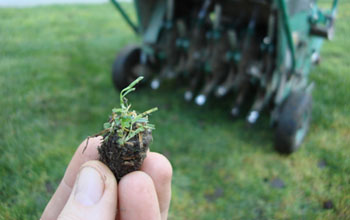
2. Fertilize: Fertilizing in the fall, before the first frost, helps your grass survive a harsh winter. It provides nutrients to reach roots for your grass to grow a stronger root system over the winter. This will result in a healthier and stronger lawn next spring. We recommend choosing a product high (10% to 15%) in phosphorous, which is critical for root growth.
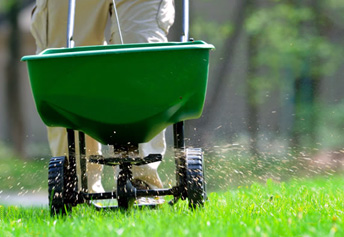
3. Weed Control: If broadleaf weeds like dandelions have taken over your lawn, now’s the time to fight back. Weeds are germinating like crazy in the fall, so make sure you apply a pre-emergent as soon as possible. The best time to apply a pre-emergent to combat winter weeds is in August or September.
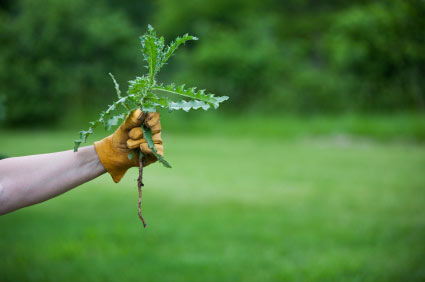
4. Rake: While those leaves can look pretty on the lawn, the leaves decay which negatively affects the grass. When there is a blanket of leaves on the lawn, sunlight cannot get through to the grass. Rake up the leaves at least once a week.
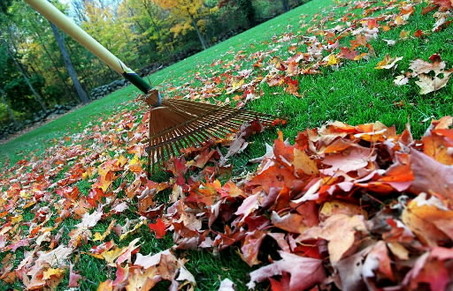
5. Mowing: Mowing your law is the single most important thing you can do to manage the vigor of your grass and its ability to compete against weeds. In the fall, the best results are obtained by mowing at the highest setting on your mower. In no case should the mowing leave the grass less than 1.5 inches (3.75 cm) tall. This will help insulate the grass during the winter.

Lastly, if you are not certain how to proceed or do not want to deal with the hassle, contact a professional lawn company in Sonoma County that provides year-round lawn care.
Protecting Your Landscape From Frost Bite
The temperatures in Northern California are beginning to drop which means winter will be before us, before we know it. Night time temperatures that get down to freezing and below will damage some trees and plants if you don’t take precautions against frost. These low temperatures can begin late November and continue through February and beyond.
DK Landscaping helps you prepare your landscape and provides tips to protect your delicate plants from frost bite.
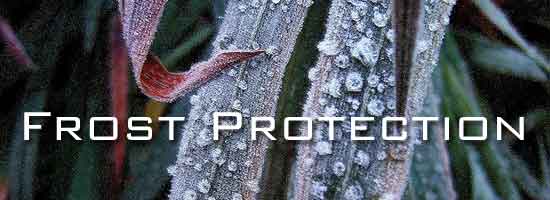
WINTERIZE
Fall is prime time to clean up your landscaping and remove the dead landscaping before it gets too cold. Removing dead plants can also stop the growth and spread of fungi that could infect your plants’ new growth in the spring.
PLANT
Planting trees and shrubs in the fall is a an optimal time before the first frost arrives and best time to take advantage on some great end of the season deals. Planting in the fall gives roots plenty of time to become established before the next growing season begins. Not only will you get to enjoy the changing leaves for a brief time, you will also put less stress on your young trees because of the cooler weather and rain conditions fall offers.
MULCH
Mulching can be a great first step in preparing for winter’s frost. If you are unfamiliar with mulching, check out our previous blog post called Mulch About Fall. There are many benefits to mulching your lawn and plants, especially before winter. Mulching in the fall can help protect your plant’s roots as well as help them retain moisture during the cold, dry winter.
Just a few preparations for winter can guarantee that your landscaping will come back fresher than ever in the spring.
For more information on the care of your landscape, please contact David or Kathy Lee from DK Landscaping (707) 280-3632.
Mulch About Fall

Did you know that mulching in the fall is just as important as it is in the spring and summer months? We mulch in the spring and summer months to suppress weeds, retain moisture and feed and warm the soil. However, when the temperatures begin to drop and the ground freezes, root systems can be exposed. The primary reason for winter mulching is to protect our plants from the harsh conditions of winter freezes, thaws and winds. Mulch acts as an insulator to balance the temperature creating a warm, heavy blanket of protection.
Neglecting to mulch in the fall can be damaging to your plants in the spring season. And the cost of mulching is nothing compared to the cost of replacing some of your favorite trees and shrubs. It also adds a beautiful aesthetic to your landscape in the winter months.
Using fall leaves as organic mulch is a great benefit to your landscape. They will break down over the course of the wintertime and create a layer of nutrients for your plants to draw from. Adding a layer of leaves over your perennials will help regulate soil temperature of the wintertime, as well as give new shoots a protective blanket as they enter the world in the spring.
DK Landscaping offers mulching installation in Sonoma County. Contact us for more information on the benefits of fall mulching (707) 280-3632.


